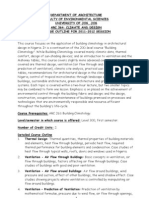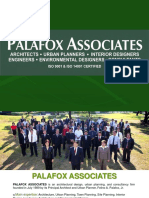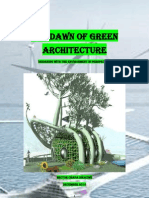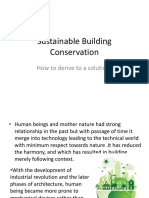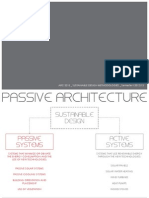Climate Responsive
Climate Responsive
Uploaded by
Manish BokdiaCopyright:
Available Formats
Climate Responsive
Climate Responsive
Uploaded by
Manish BokdiaOriginal Description:
Original Title
Copyright
Available Formats
Share this document
Did you find this document useful?
Is this content inappropriate?
Copyright:
Available Formats
Climate Responsive
Climate Responsive
Uploaded by
Manish BokdiaCopyright:
Available Formats
International Conference Passive and Low Energy Cooling for the Built Environment, May 2005, Santorini, Greece
699
Traditional Indian architecture - The future solar buildings
D. Vyas
School of Architecture, IPS Academy, India
ABSTRACT Built environment is a manifestation of the technological innovation. The way technologies are applied in design and construction of buildings, have direct implications on the amount of energy consumed. In modern context buildings represent enclosed, isolated boxes/systems where environment is artificially controlled. This requires considerable energy. A problematic relationship between architecture and technology is evident. A large part of Indian Subcontinent has for majority of year ample Sun- renewable, nonpolluting, abundant and direct source of all present natural cycles on earth. For building design in majority of these regions, the necessity is to control and utilize this abundance. History shows the importance of relationship between human activity and nature. Human lives remained much dictated by solar and seasonal cycles, instead of trying to homogenize living conditions throughout the year. The future is in living and working with nature rather than against it. In traditional Indian architecture this harmony with nature was an important design element. During the course of development, somewhere, harmony was subdued for artificial control resulting in buildings without context. Can we revive and refine these forgotten principles of traditional Indian architecture? The study deals with exploration and understanding of these principles. This approach is sustainable and a site sensitive approach. The fundamental principles of this approach are- Buildings to be a buffer against uncomfortable environmental conditions.
- Buildings to enhance the positive natural conditions to reach the internal space. - Buildings to be environmentally responsive to their natural surroundings. Case examples from different regions in Indian subcontinent were studied with respect to their climatic context. The results indicate that the buildings in harmony with nature have lesser need for energy as compared to energy hungry architecture of today. 1. INTRODUCTION Sun is the source and sustenance of every aspect of life on the earth. Suns energy is essential for the formation of wind, clouds, rain and other weather conditions thus resulting in different climates on earth. Natures solar energy users have highly efficient and sophisticated ways of getting the most from their power source. Plants are efficient solar collectors and harvest solar energy, thus forming the starting point of food chain the cycle of sustainability. Animals are consumers and are equipped with their own high performance energy management systems to allow them to survive in environmental conditions that could be otherwise fatal. Best examples are polar bear and camel, which have evolved to live in extreme weather conditions. Human body gets acclimatized to a certain extent but human skin performance is limited. Clothing and shelter compensate for this. Buildings provide shelter, facilitates our activities and interactions, represent our desires and provide cultural expression. Through out history, humans have been adaptable and have developed energy efficient building forms suited to varying climatic condi-
700
International Conference Passive and Low Energy Cooling for the Built Environment, May 2005, Santorini, Greece
tions thus achieving comfort. With industrialization came the technologies of transforming energy into heat. Most innovations were in fossil fuel power, electricity and gas. The experience of being able to capture sunlight in greenhouses ignited the possibility of controlling vast areas of artificial environment. With globalization came a multinational corporate building style sealed glass box that was dependent on a huge energy supply. A style, that gave rise to buildings without any consideration to their context (in particular, to the site and climate). Buildings are treated as an insulated thermos flask with their own internal environment and with their comfort level independent of outside conditions (Yeang, 1987). People no longer interact with the built environment to find an acceptable level of comfort. (Rather the concept of acceptable level of thermal comfort has also changed). The building with its incorporated technology takes care of everything but at the cost of large non-renewable source of energy. As of now buildings consume in both construction and operation, half of the total energy that is used by human beings (Behling and Behling, 2000). This needs introspection by professionals in the field of settlement planning, building science and design. They are responsible for dictating the energy requirements at different levels. For example, if structures in tropical climates are designed, that use a lot of glazing on west, the energy requirements of buildings will necessarily incorporate the energy costs of artificially cooling the internal space. Similarly if a building has insufficient window space, use of artificial lighting has to be adhered to, thus, resulting into increased energy consumption. Urban settlements with improper considerations lead to heat island impact, leading to an even greater catastrophe. This necessitates an ethical approach towards our environment. The technology alone can no longer be assumed to provide solutions; the key rather lies in re-evaluating our own ways. The solution to this is a sustainable and site sensitive design approach. A glimpse of architectural practices in past shows an efficient use of this approach. Traditional architecture in any place, as observed today, is not the result of a one-time effort but is the culmination of hundreds of years
of understanding in response to a particular situation through trial and error. This articulation and its crystallization, is more evident in areas with extreme conditions and meager resources. It exemplifies a negotiation between man and nature. These shelter forms have an important attribute of making its inmates comfortable in extreme climatic conditions. Overall a harmonious balance between built form, climate and lifestyle was achieved. 2. INDIAN CONTEXT India is a tropical country with diverse traditional shelter forms, not only in vernacular architecture but also in spectacular architecture where comfort has been of primal importance. The country has been divided into six different regions with distinct climate (Bansal and Minke, 1988). A study of case examples from hot dry and warm humid zones has been made. The characteristic features for the same can be studied according to Table 1: 2.1 Case examples from hot dry zone: Situated in the heart of the Thar Desert, Jaisalmer is a town where the builders in medieval times have created an urban environment that
Figure 1: Climatic zones of India.
International Conference Passive and Low Energy Cooling for the Built Environment, May 2005, Santorini, Greece
701
Table 1: Characteristic features of climatic zones.
Table 2: Solar shading analysis.
Climatic feaHot dry zone tures Landscape and Relatively vegetation flat/sandy or rocky ground. Scarce vegetation. Solar radiation Intense (800-950 W/Sq.m per hour) Ambient temperature Summer day 40-45 0c 20-30 0c night 5-25 0c Winter day 0-10 0 c night Diurnal varia> 10 0 c tion Relative humid- 25-40 % ity (very low) Precipitation Less than 500 mm per year Dusty winds / sand storms in afternoons Sky conditions Clear sky Winds
Warm Humid zone Relatively flat regions with abundant vegetation. diffused radiation
Street orientation E-W E-W
30-35 0c 25-30 0 c 25-30 0c 20-25 0 c 70-90 % (High) Greater than 1200 mm per year Variable and generally high during summer Generally overcast
N-S
Solar exposure on facade 9.30 AM to 2.30 PM on south facade Before 8.00 AM and after 4.00 PM on north facade Up to 11.30 AM on east facade and after 12.30 on west
Solar alt. 54 to 860 < 350
Analysis Small horizontal projections suffice Shaded by opposite buildings
Narrow street and Varies from 0-790 hence shaded before 10.30 AM and after 1.30 PM. Incident solar radiation not more than one hour on each facade.
overcomes the problems of extreme climate conditions by special passive design features. 2.1.1 Site planning and design Flat land with scarce vegetation and even scarce water, the town was planned with major streets oriented along E-W and minor streets at right angles to these. The heights of the buildings are 1 to 2 times street width of main street and 4 times the street width for N-S streets. Buildings are of unequal heights with wind pavilions and high parapet walls, creating an uneven skyline and shading each other, thus reducing sol-air temperature. An uneven building form also increases the radiative heat loss from building to sky (sky acting as a heat sink) (Sodha, et al., 1986). Compact planning with 56 m high wall around the town takes care of sand storms. 2.1.2 Plan form and three-dimensional configurations Depending on the socio economic status of in-
habitant, there are three types of houses. The simple town house with single room, verandah and a courtyard, two to three storey structure with additional rooms and small enclosed terraces on upper floors, and most complex of all haveli (four- five storey houses consisting of one or two courts with underground rooms in levels and terraces enclosed by wind pavilions and high parapet walls). The plan elements incorporated are courtyards along with narrow vertical ducts and staircase shafts for deflecting wind into the built
Figure 2: A haveli, Jaisalmer: Plan and section.
702
International Conference Passive and Low Energy Cooling for the Built Environment, May 2005, Santorini, Greece
form. Coupled with high thermal inertia, these shafts act in a similar way as Iranian wind towers. Basements are there invariably in all houses but are used as storage/strong rooms and not as living spaces. Surface area to volume ratio (Krishnan et al., 2001) is low for the basic urban form but is increased manifolds by ornamentation and by arranging the building mass in an uneven form. Although domical or vaulted roofs would have performed effectively, the built forms have a flat roof owing to functional reasons. The terrace acts as an activity space in winter days and sleeping area for summer nights. Also this has resulted into high-rise compact forms with cooler lower floors. 2.1.3 Building Envelope Walls are 45 cm or more in thickness built of light yellow sandstone. At upper floor level projections of 5 cm thick panels of limestone, deep carved in geometric patterns are used as wall elements. Roofs are 45 to 60 cm thick (closely spaced timber beams covered with reed or grass matting and a thick layer of earth on top). Stone slabs have also been used in later times owing to scarcity of timber. Such roofs have a low decrement factor (0.162) and large (24 hr) time lag (Nayak et al., 1999). This shows that ceiling, roof surface and ambient air reaches their peak at about same time (Contrary to the modern belief). Psychologically a higher temperature can be tolerated well in the day than at night. Openings are generally small and windows fitted with solid timber shutters. Fenestration acts as an important design element. Large number of projections like sunshades and balconies acted as effective shading device not only for the openings but also for the walls. Micro shading of surfaces i.e. deep carving on flat wall surfaces on the upper floors was done, thus, achieving the benefits of extended surface. It results into increased convective heat transfer to air thus cooling the wall early, in the evening. As per a study, made by Gupta (1984) temperatures were measured for various types of buildings and following inferences were drawn: 1. The street maximum daytime temperatures in summers were 1.5 to 2.5 oC lower than metrological data while in winter this difference was less than 1 oC. The night street tempera-
tures on the other hand were elevated by 3 to 5 oC in winters, while in summers the corresponding elevation was only 0.5 to 3.5 oC. This shows the positive impact of urban form on microclimate. 2. Thermal performance of haveli is best of all houses. Maximum indoor temperature was 8 o C lower than the outdoor maximum. 3. Smaller decrement factor reduces the heat flux entering the building. 4. The compact built form with courtyard system is more effective than modern bungalow type development. An important aspect of these structures was arrangement of activities in space and time. Cooler lower floors and shaded courts were used for daytime activities and upper floors and terraces for nighttime sleeping. 2.2 Case examples from warm & humid zone This type of climate is mainly found in the coastal belts. Traditional settlements in Kerala typically highlight a positive influence of the built form and natural resources available. 2.2.1 Site planning and design The houses are detached type with extended open spaces all round, thus enabling good air access. Excessive vegetation helps in giving the much-needed shade and low reflected radiation for the tropical conditions. The orientation of main streets is along E-W axis (with a tilt up to 20o in some cases) along the prevailing wind direction thus enhancing comfort conditions. 2.2.2 Plan form and three-dimensional configurations The basic house module is nalukettu, four blocks built around a courtyard into which the roof slopes on four sides, protecting an internal verandah from rain and sun. Depending on the size and importance of the household the buildings have one or two upper storeys or further enclosed courtyard by repetition of the nalukettu to form ettukettu (eight blocks building) or a cluster of such courtyards. The enclosed courtyard is usually sunk such that cooler air settles down. The external slope descends low over the outer walls, covering another verandah at the front of the building. The inner verandah around the court is open. The outer verandahs along the
International Conference Passive and Low Energy Cooling for the Built Environment, May 2005, Santorini, Greece
703
decorative jali from where hot air rises and flows out. The roofs enclose a large insulated air space thus, keeping the lower areas cooler. 2.2.3 Building Envelope Walls in the upper floors comprises of ranks of struts connected by spaced slats thus becoming a part of fenestration design for the ease of good airflow, thus keeping the rooms cool and gently lit. On the lower areas the walls are of laterite (for privacy reasons) but being shaded by sloping roofs and extended verandahs, the sol-air temperature is low thus reducing heat gain. An important aspect of these settlements is usage of courtyards both external and internal not just as green areas but they were major activity spaces where bathing, cooking, sleeping and socializing could take place at different points of time. 3. LIFSTYLE TRENDS AND ENERGY The typology of spaces that evolved in both the cases due to extremes of nature are reflections of the lifestyle of the inhabitants as well. The activity patterns were in turn governed by daily and seasonal solar cycles. Today, with the technological twists to lifestyles, building typologies gets dictated by
Spaces in warm humid zones Shaded corridors of temples Present state
Figure 3: Traditional house, Kerala: Plan and section.
four sides of the nalukettu are enclosed differently. While both the western and eastern verandahs are left open to ensure good inlets for day and night breeze, the northern and southern verandahs are enclosed or semi-enclosed. Roofs have steep pitches almost 40-45 degrees. Further gable windows are there at the two ends to provide attic ventilation when ceiling was incorporated for the room spaces. This ensured air circulation. Even in the absence of the ceiling these gables have an opening with a
Table 3: Activity pattern and energy usage.
Daytime/Night time activities Men Trade / Ritual performances / meetings Household Study/playing Social gatherings, entertainment (afternoons and evenings) Night time activities
Women children Men, women and children Men, women and children
Space in hot dry zones Semi covered platforms on lower floors abutting the shaded street Courtyards/ rooms abutting courts Courts/Shaded streets Open streets and chowks
Summer- terraces and open courts Winter rooms on upper floors
Glass faced air conditioned spaces. Mechanically controlled comfort achievement. Rooms abutting Artificially lit rooms, excourts with louvered hausts / fan induced ventiopenings lation. Artificially lit classrooms Trees / Semi covered with fan induced ventilaverandahs/external tion. open spaces Shaded temple manLarge air conditioned/ dapas mechanically cooled spaces. Generally in late evenings and hence artificially lighted. Monsoons Throughout the year in air Rooms with louvered conditioned or closed walls rooms with air coolDry internal court of ers/fans nallukettu
704
International Conference Passive and Low Energy Cooling for the Built Environment, May 2005, Santorini, Greece
them. The most important difference is the use of mechanical devices for conditioning and lighting of spaces. Another important consideration is the user adaptability to the ease of comfort. A comparison of activity patterns of users and the related spaces indicates the changes in energy requirements in the same regions today. 4. CONCLUSION Control of the microclimate was always an important aspect of indigenous Indian architecture. In this one may find appropriate concepts, if not models to address todays problems. This does not mean reverting back to uninformed folk culture. Rather these concepts can be clubbed with the benefits of global information and nurtured with intelligence of the technology, thus easing of, relationship between architecture, its context and technology. The major issues here are 1. Design of microclimate (as respecting the immediate out side conditions results into satisfactory indoor conditions). 2. Integration of comfort sources passive techniques adaptability 3. Climate as an architectural generator along with many others such as culture, traditions and trends. An important factor is the willingness and the ability of the user to organize his daily activities in space and time so that not all spaces required to be maintained at equal levels of comfort all the time. At any given time, active use of a building could be restricted to the areas most comfortable at that time. This requires transformation of lifestyles to be more concordant with natural environmental systems. Architecture is at the forefront of energy and resource consumption. Energy guzzling mega structures randomly spread through out the world, irrespective of climate, location on the planet and cultural context are symptomatic of a global havoc. The future solar buildings are to redefine architecture beyond technical and performance values, collectively designing with context of place.
REFERENCES
Bansal, N.K and G. Minke, 1988. Climatic zones and rural housing in India, Germany: Kernforschungsanlage, Juelich. Behling, S. and St. Behling, 2000. Solar Power-The Evolution of Sustainable Architecture. Munich, London, New York: Prestel Verlag Gupta, V., 1984. A study of natural cooling systems in Jaisalmer, Delhi, Ph.D Thesis, IIT. Heschong, L., 1979. Thermal delight in architecture. London: The MIT Press, Cambridge, Massachusetts. Kulbhushan J. and Minakshi, 2000. Architecture of the Indian Desert. Ahmedabad: AADI centre. Kulbhushan J. et al., 2002. Thematic space in Indian Architecture. Ahmedabad: AADI centre. New Delhi: India research press. Krishnan, A., et al., 2001.Climate Responsive Architecture-A design handbook for energy efficient buildings.New Delhi:Tata Mcgraw Hill Publishing Co. Ltd. Nayak, J.K., et al., 1999. Manual on Solar passive Architecture. New Delhi: SEC, MNES, GOI. Sodha, M.S., et al., 1986. Solar Passive Building Science and Design. M A S :Pergamon Press Yeang, K., 1987. Tropical Urban Regionalism Building in a South East Asian city. Singapore: Concept Media Pte Ltd.
You might also like
- The Lord's Prayer OutlineDocument7 pagesThe Lord's Prayer Outlinemaddogyp100% (2)
- Question 1 (1 Point)Document44 pagesQuestion 1 (1 Point)milanchabhadiya288No ratings yet
- Transportation and Sustainable Campus Communities: Issues, Examples, SolutionsFrom EverandTransportation and Sustainable Campus Communities: Issues, Examples, SolutionsNo ratings yet
- Tropical Residential Building Presentation (Revised)Document22 pagesTropical Residential Building Presentation (Revised)Gerard Bicarme LebantinoNo ratings yet
- Site AnalysisDocument6 pagesSite AnalysisChandan RawatNo ratings yet
- Green Architecture A Concept of SustainabilityDocument11 pagesGreen Architecture A Concept of SustainabilityNguyen Duy AnhNo ratings yet
- Green Surfaces: Known As "The Green Space of Qeshm Island"Document5 pagesGreen Surfaces: Known As "The Green Space of Qeshm Island"Sneha KalyanNo ratings yet
- Appropriate Conservation and Preservation Methods of HeritagesDocument7 pagesAppropriate Conservation and Preservation Methods of HeritagesLole TubeNo ratings yet
- Unit Iv-Issues of Urban SpaceDocument21 pagesUnit Iv-Issues of Urban SpaceKabi lanNo ratings yet
- Themes of Good Urban DesignDocument5 pagesThemes of Good Urban DesignJess RomusNo ratings yet
- Green ArchitectureDocument25 pagesGreen Architectureshadan khan100% (1)
- 2ar8 TD Presentation - Ang - Manto - Querido - Raqueno - TahilDocument17 pages2ar8 TD Presentation - Ang - Manto - Querido - Raqueno - TahilISABELLE MAXINE MANTONo ratings yet
- Ecistics The Science of Human SettlementsDocument15 pagesEcistics The Science of Human SettlementsCyhn GieNo ratings yet
- Architectural Policy: Poetic ArchitectureDocument6 pagesArchitectural Policy: Poetic ArchitectureKonZabetas Architects-engineersNo ratings yet
- 01-Ar173-8th Sem-Landscape Design and Ecological Architecture-Unit 1-Part1Document24 pages01-Ar173-8th Sem-Landscape Design and Ecological Architecture-Unit 1-Part1VICKY KUMARNo ratings yet
- 14national Land Use PolicyDocument18 pages14national Land Use PolicyYash K. JasaniNo ratings yet
- Vernacular Architecture and ClimateDocument2 pagesVernacular Architecture and Climateshahid rasoolNo ratings yet
- ProfQuiz Tropical Design 1Document37 pagesProfQuiz Tropical Design 1Lloyd AnchetaNo ratings yet
- CDP Site Analysis Neighborhood ContextDocument8 pagesCDP Site Analysis Neighborhood ContextNazarulNo ratings yet
- Vernacular Architecture and Its Relation With Sustainable Contemporary Architecture in IndonesiaDocument20 pagesVernacular Architecture and Its Relation With Sustainable Contemporary Architecture in Indonesiafabrian baharNo ratings yet
- Climate Responsive Architecture Creating Greater Design Awareness Among Architects PDFDocument11 pagesClimate Responsive Architecture Creating Greater Design Awareness Among Architects PDFChirag Hablani100% (1)
- UJ ARC 364 Climate and Design Course Outline 120311aDocument5 pagesUJ ARC 364 Climate and Design Course Outline 120311aIvan AvramovNo ratings yet
- BS-SD-10-FinalDocument13 pagesBS-SD-10-FinalRashmi yelpureNo ratings yet
- Philippine ClimateDocument6 pagesPhilippine ClimateN/ANo ratings yet
- Vernacular ArchDocument11 pagesVernacular ArchRomel Ryan MartinezNo ratings yet
- Nipa HutDocument6 pagesNipa HutLaura SacdalanNo ratings yet
- Community Planning Development 12Document6 pagesCommunity Planning Development 12Johnvirgo CorpuzNo ratings yet
- Renewable and Sustainable Energy Reviews: A.R. Dehghani-Sanij, M. Soltani, K. RaahemifarDocument14 pagesRenewable and Sustainable Energy Reviews: A.R. Dehghani-Sanij, M. Soltani, K. RaahemifarNaynaNo ratings yet
- Amalgamation of Nature and ArchitectureDocument7 pagesAmalgamation of Nature and Architecturepriyesh_d100% (1)
- Asia CEO Forum-PalafoxDocument228 pagesAsia CEO Forum-PalafoxBriccioNo ratings yet
- Housing Planner WorksDocument7 pagesHousing Planner WorksKim LucenaNo ratings yet
- Dawn of Green ArchitectureDocument25 pagesDawn of Green ArchitectureDr Hector C Sikazwe100% (1)
- Eco TowersDocument1 pageEco TowersThe London Free PressNo ratings yet
- Architecture and Culture: Built Environment, Landscape and SocietyDocument2 pagesArchitecture and Culture: Built Environment, Landscape and SocietyMalavikaNo ratings yet
- Housing AssignmentDocument2 pagesHousing AssignmentAishwarya KambleNo ratings yet
- All Lectures in One FileDocument188 pagesAll Lectures in One FileMuhammad Junaid Anis100% (1)
- Urban DesignDocument42 pagesUrban DesignDamanpreet Dandiwal0% (1)
- Technology of Complex Building Assignment - 20161002Document31 pagesTechnology of Complex Building Assignment - 20161002Frankie LeungNo ratings yet
- The Importance of Sustainability in Architecture and EconomyDocument4 pagesThe Importance of Sustainability in Architecture and EconomySaurabhNo ratings yet
- Tropical Design ReviewerDocument7 pagesTropical Design ReviewerJOEMARI MAUHAYNo ratings yet
- Notes 1Document20 pagesNotes 1Aayushi GoyalNo ratings yet
- Living Architecture Rachel Armstrong The Bartlett School of ArchitectureDocument109 pagesLiving Architecture Rachel Armstrong The Bartlett School of ArchitectureGregory CrawfordNo ratings yet
- Urban DesignDocument9 pagesUrban DesignsamiahfathimaNo ratings yet
- Rethinking and Redesigning The Urban LandscapeDocument7 pagesRethinking and Redesigning The Urban LandscapeSandra FremNo ratings yet
- Housing Demand and SupplyDocument4 pagesHousing Demand and SupplygurulakshmiNo ratings yet
- Climate ChangeDocument1 pageClimate ChangeVincent William RodriguezNo ratings yet
- Sustainable Building ConservationDocument47 pagesSustainable Building ConservationDrGarima DikshitNo ratings yet
- The Brown Bauhaus STUDIO ARCHITECTURE: Fundamental Course - Comprehensive Ale Review + Preparation ProgramDocument10 pagesThe Brown Bauhaus STUDIO ARCHITECTURE: Fundamental Course - Comprehensive Ale Review + Preparation ProgramClaro III TabuzoNo ratings yet
- Passive Vernacular Architecture-LibreDocument31 pagesPassive Vernacular Architecture-LibreFarheen BanoNo ratings yet
- Solar Passive TechniquesDocument13 pagesSolar Passive TechniquesAnkit Kashmiri GuptaNo ratings yet
- Contemporary GardenDocument5 pagesContemporary GardenShubhangi SinghNo ratings yet
- Site AnalysisDocument4 pagesSite AnalysisZarkima RanteNo ratings yet
- Sustainability 10 03629 PDFDocument15 pagesSustainability 10 03629 PDFPragathi VenkateshNo ratings yet
- ECM5 Technical Information Warm-Humid PDFDocument77 pagesECM5 Technical Information Warm-Humid PDFharish guptaNo ratings yet
- A Vertical Mixed-Used Complex Development: National UniversityDocument48 pagesA Vertical Mixed-Used Complex Development: National UniversityVictor FrutoNo ratings yet
- Socio Cultural Basis of Design in CommunitiesDocument44 pagesSocio Cultural Basis of Design in CommunitiesUniqueQuiverNo ratings yet
- AD Sun and Wind DirectionDocument6 pagesAD Sun and Wind DirectionKeena Perez100% (1)
- Thesis Outline Manual: - Introduction Background of The StudyDocument32 pagesThesis Outline Manual: - Introduction Background of The StudyJaime AlanoNo ratings yet
- The Accidental Playground: Brooklyn Waterfront Narratives of the Undesigned and UnplannedFrom EverandThe Accidental Playground: Brooklyn Waterfront Narratives of the Undesigned and UnplannedNo ratings yet
- Naga Tower, Gift City, Gujarat - Architect's Review - Architecture IdeasDocument7 pagesNaga Tower, Gift City, Gujarat - Architect's Review - Architecture IdeasManish BokdiaNo ratings yet
- WTC GIFT Studios Residential Apartments at World Trade Center GIFT City Gujarat - Sandeep PandyaDocument8 pagesWTC GIFT Studios Residential Apartments at World Trade Center GIFT City Gujarat - Sandeep PandyaManish BokdiaNo ratings yet
- Modi's 'GIFT' Can Rival Mumbai - RediffDocument3 pagesModi's 'GIFT' Can Rival Mumbai - RediffManish BokdiaNo ratings yet
- INDIAN CORPORATE LAW - GIFT City - A New Chapter in The Indian Financial Sector - Part 1Document6 pagesINDIAN CORPORATE LAW - GIFT City - A New Chapter in The Indian Financial Sector - Part 1Manish BokdiaNo ratings yet
- Government of Gujarat: Gujarat International Finance Tec-City (GIFT) - A Global Financial HubDocument2 pagesGovernment of Gujarat: Gujarat International Finance Tec-City (GIFT) - A Global Financial HubManish BokdiaNo ratings yet
- Topotek 1, Landscape Master Plan For GIFT City (India) - Arquitectura Viva Architecture MagazinesDocument1 pageTopotek 1, Landscape Master Plan For GIFT City (India) - Arquitectura Viva Architecture MagazinesManish BokdiaNo ratings yet
- IFSC Project As Per Schedule - GIFT - LivemintDocument5 pagesIFSC Project As Per Schedule - GIFT - LivemintManish BokdiaNo ratings yet
- GIFT City To Help India Become Reinsurance Hub - Business Standard NewsDocument5 pagesGIFT City To Help India Become Reinsurance Hub - Business Standard NewsManish BokdiaNo ratings yet
- GIFT in Gujarat - Narendra Modi's Dream Project Offers Vital Learnings For 100 Smart Cities Ambition - Timesofindia-EconomictimesDocument4 pagesGIFT in Gujarat - Narendra Modi's Dream Project Offers Vital Learnings For 100 Smart Cities Ambition - Timesofindia-EconomictimesManish BokdiaNo ratings yet
- GIFT CITY - Daily - BhaskarDocument5 pagesGIFT CITY - Daily - BhaskarManish BokdiaNo ratings yet
- Getting To Know India's First SMART City - The GIFT City ! - IAS OUR DREAMDocument6 pagesGetting To Know India's First SMART City - The GIFT City ! - IAS OUR DREAMManish BokdiaNo ratings yet
- Competitive Tax Regime A Must For GIFT's Success, We Have Proposed 3%' - The Indian ExpressDocument10 pagesCompetitive Tax Regime A Must For GIFT's Success, We Have Proposed 3%' - The Indian ExpressManish BokdiaNo ratings yet
- GreenDocument1 pageGreenManish BokdiaNo ratings yet
- A Trip Down The Rabbit Hole of Modi's Smart Cities Wonderland - The WireDocument7 pagesA Trip Down The Rabbit Hole of Modi's Smart Cities Wonderland - The WireManish BokdiaNo ratings yet
- Outline 2006-07Document196 pagesOutline 2006-07Manish BokdiaNo ratings yet
- EXPERT LECTURE - Dinesh VaswaniDocument2 pagesEXPERT LECTURE - Dinesh VaswaniManish BokdiaNo ratings yet
- Assignment 1B PA102715Document1 pageAssignment 1B PA102715Manish BokdiaNo ratings yet
- Release Final - João GordoDocument2 pagesRelease Final - João GordoHomero JanuncioNo ratings yet
- 64 - Mindtree Brochures Murex Datamart Performance Optimization PDFDocument4 pages64 - Mindtree Brochures Murex Datamart Performance Optimization PDFpurushottam100% (1)
- Spare The Rod and Spoil The Child EssayDocument7 pagesSpare The Rod and Spoil The Child Essayafabidbyx100% (2)
- Ultimate Guide For Descriptive English: Free E-BookDocument11 pagesUltimate Guide For Descriptive English: Free E-BookRaja ShekarNo ratings yet
- Maths Formula Pocket Book Maths Formula-Page62Document1 pageMaths Formula Pocket Book Maths Formula-Page62Ernie LahaylahayNo ratings yet
- Project ManagementDocument27 pagesProject Managementfahim25No ratings yet
- FINALS Emtech PR2Document10 pagesFINALS Emtech PR2Lhay GonzalesNo ratings yet
- The True Sabbath PDFDocument32 pagesThe True Sabbath PDFEugenius Divine LoveNo ratings yet
- (English) Timothy Goes To School - Timothy Goes To School - Yoko - Ep.1 (DownSub - Com)Document18 pages(English) Timothy Goes To School - Timothy Goes To School - Yoko - Ep.1 (DownSub - Com)Diem DXNo ratings yet
- Pre-Test: Multiple Choice: Choose The Letter of The Correct Answer. Write Your Answer On ADocument20 pagesPre-Test: Multiple Choice: Choose The Letter of The Correct Answer. Write Your Answer On AI am julia VillagonzaloNo ratings yet
- Gym Management System SoftwareDocument8 pagesGym Management System SoftwareIntouchGroupNo ratings yet
- Masters Business Administration Thesis TopicsDocument5 pagesMasters Business Administration Thesis Topicsfjfcww51100% (2)
- 2018-09-01 Stamp & Coin Mart PDFDocument94 pages2018-09-01 Stamp & Coin Mart PDFClaudiusNo ratings yet
- QUIZ 6A: Singular and Plural Nouns: BeginningDocument1 pageQUIZ 6A: Singular and Plural Nouns: Beginningz_eguyNo ratings yet
- Bollas FreeAssociationDocument55 pagesBollas FreeAssociationFAUZI PALIS JUNIORNo ratings yet
- Statistical Issues in Bioavailability Bioequivalence Studies Jbb.S1 007Document8 pagesStatistical Issues in Bioavailability Bioequivalence Studies Jbb.S1 007Yi XinNo ratings yet
- Use Equals Sign To Determine Missing Numbers Algebra Level 3 Worksheet - Ver - 3Document13 pagesUse Equals Sign To Determine Missing Numbers Algebra Level 3 Worksheet - Ver - 3Fatima AliuNo ratings yet
- Past Simple More 2Document2 pagesPast Simple More 2macNo ratings yet
- Design of A 100w Power Amplifier With Darlington Complementary Symmetry Output Power TransistorDocument61 pagesDesign of A 100w Power Amplifier With Darlington Complementary Symmetry Output Power TransistorZachNervesNo ratings yet
- Geed 10063 Purposive CommunicationDocument7 pagesGeed 10063 Purposive CommunicationMary Lyka RotairoNo ratings yet
- Chapter 10 CommunicationDocument38 pagesChapter 10 CommunicationZahir SherNo ratings yet
- Gossip ArticleDocument4 pagesGossip Articleapi-534406063No ratings yet
- Research Paper On Snow WhiteDocument4 pagesResearch Paper On Snow Whitezepewib1k0w3100% (1)
- 1 TypesDocument5 pages1 TypesOfentse Boat bouyNo ratings yet
- Domestication in TranslationDocument8 pagesDomestication in TranslationMuhammad QasimNo ratings yet
- BMEDocument7 pagesBMEantony dhinakarNo ratings yet
- Psy Chapter 2Document146 pagesPsy Chapter 2OceanNo ratings yet
- BabyDocument2 pagesBabyJanea ArinyaNo ratings yet






















